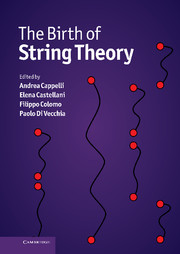Book contents
- Frontmatter
- Contents
- List of contributors
- Photographs of contributors
- Preface
- Abbreviations and acronyms
- Part I Overview
- EARLY STRING THEORY
- Part II The prehistory: the analytic S-matrix
- Part III The Dual Resonance Model
- Part IV The string
- TOWARDS MODERN STRING THEORY
- Part V Beyond the bosonic string
- 27 Introduction to Part V
- 28 From dual fermion to superstring
- 29 Dual model with fermions: memoirs of an early string theorist
- 30 Personal recollections
- 31 Aspects of fermionic dual models
- 32 The dual quark models
- 33 Remembering the dawn of relativistic strings
- 34 Early string theory in Cambridge: personal recollections
- Part VI The superstring
- Part VII Preparing the string renaissance
- Appendix A Theoretical tools of the Sixties
- Appendix B The Veneziano amplitude
- Appendix C From the string action to the Dual Resonance Model
- Appendix D World-sheet and target-space supersymmetry
- Appendix E The field theory limit
- Index
34 - Early string theory in Cambridge: personal recollections
from Part V - Beyond the bosonic string
Published online by Cambridge University Press: 05 May 2012
- Frontmatter
- Contents
- List of contributors
- Photographs of contributors
- Preface
- Abbreviations and acronyms
- Part I Overview
- EARLY STRING THEORY
- Part II The prehistory: the analytic S-matrix
- Part III The Dual Resonance Model
- Part IV The string
- TOWARDS MODERN STRING THEORY
- Part V Beyond the bosonic string
- 27 Introduction to Part V
- 28 From dual fermion to superstring
- 29 Dual model with fermions: memoirs of an early string theorist
- 30 Personal recollections
- 31 Aspects of fermionic dual models
- 32 The dual quark models
- 33 Remembering the dawn of relativistic strings
- 34 Early string theory in Cambridge: personal recollections
- Part VI The superstring
- Part VII Preparing the string renaissance
- Appendix A Theoretical tools of the Sixties
- Appendix B The Veneziano amplitude
- Appendix C From the string action to the Dual Resonance Model
- Appendix D World-sheet and target-space supersymmetry
- Appendix E The field theory limit
- Index
Summary
In from the periphery
At the University of Helsinki, where I took my BSc and MSc degrees, research in and teaching of modern theoretical physics had started in the early Sixties after a long period of stagnation. In particle physics, introduced to Finland by amongst others K. V. Laurikainen, the emphasis was on phenomenology.
Enthusiastic young teachers like Keijo Kajantie taught us the basics of S-matrix and Regge theory. When Veneziano's paper appeared, it was greeted with much interest. Visits to Finland by Chan Hong-Mo, David Fairlie and Holger Bech Nielsen helped to spread the gospel. In the spring of 1970, Eero Byckling organized a study group on the Koba–Nielsen formalism, and in the summer of 1970 I was able to participate in the legendary Summer School in Copenhagen, where Nambu was not present in person, but in the form of his string action; his lecture notes were distributed among the participants.Victor Alessandrini's lectures on the multiloop amplitudes of the Veneziano model [Ale71, AA71] made a deep impression on me, and I long cherished his beautiful handwritten notes on the subject.
I was fortunate enough to receive a three-year scholarship for doctoral studies at ‘an established British university’ from the Osk. Huttunen Foundation, the very first institution in Finland which started awarding grants for long-term postgraduate studies. Being convinced that S-matrix theory was the answer to the riddle of the strong interactions, I naturally applied to Cambridge, the European Mecca of S-matrix theory.
- Type
- Chapter
- Information
- The Birth of String Theory , pp. 414 - 418Publisher: Cambridge University PressPrint publication year: 2012



